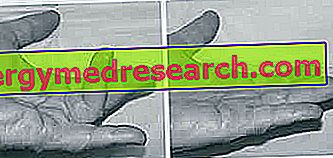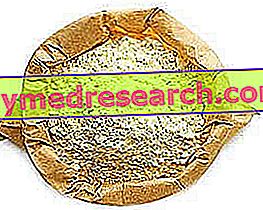Diagnosis
Since Dupuytren's disease is distinguished by very particular signs, its diagnosis requires a simple objective examination, during which the doctor evaluates the severity of the symptomatological manifestations.
At the end of a first evaluation, it is often advised to contact a hand specialist, who will advise the patient how to proceed.
EXAMINATION OBJECTIVE
During the physical examination, the doctor carefully analyzes the signs reported by the patient and collects from him all the information regarding the symptoms felt.
For the purposes of diagnosis, they are fundamental elements: skin thickening at the level of the palm of the hand, the presence of one or more nodules on the palm of the hand, flexion of one or more fingers and the inability to challenge certain objects.
SPECIALIST CONSULTATION: WHY IS IT FUNDAMENTAL?
Consultation with a hand specialist is essential to know if the disorder will get worse or worse in the future and if surgery is required.
Moreover, if the operation is necessary, it allows to establish what is the most suitable type of intervention.
Therefore, the next step after the physical examination, carried out by your doctor, is to contact an expert on hand diseases and book a specialist visit.
Treatment
The therapeutic choice for the treatment of Dupuytren's disease is very wide: in fact, non-surgical procedures, such as radiotherapy and collagenase injections of Clostridium histolyticum, and more or less invasive surgical procedures, such as percutaneous needle fasciotomy, exist palmar fasciotomy and fascectomy.
The adoption of a treatment rather than another depends exclusively on the severity of the symptomatology and on what emerged from the specialist consultation.
According to the doctors, if Dupuytren's disease:
- It is in mild form and does not affect daily manual activities (driving, holding cutlery, etc.): it is not necessary to intervene.
- It is in moderate form and partially conditions manual activities: it is first necessary to plan an adequate non-surgical therapy; subsequently, if this fails, it is necessary to switch to a surgical therapy.
- It is in severe form and markedly affects manual activities, it is necessary to operate the affected hand.
NON-SURGICAL TREATMENTS
A non-surgical treatment is chosen when the flexion of the finger is moderate and the functions of the hand affected by Dupuytren's disease are not compromised.
Non-surgical treatments, foreseen for the treatment of Dupuytren's disease, are radiotherapy and collagenase-based injections of Clostridium histolyticum (NB: Clostridium histolyticum is a bacterium).
Radiotherapy
Radiation therapy is a medical therapy that involves the use of ionizing radiation (or X-rays). In the case of Dupuytren's disease, X-rays are directed towards the affected palmar area (ie towards the nodules or the thickened area of the palm of the hand), for several consecutive days.
The results are usually satisfactory, even if you have to wait several months to appreciate them.
The exact mechanism of action of radiotherapy still presents question marks: according to many researchers, it seems that X-rays destroy aberrant fibroblasts, that is the cells responsible (or presumed to be) to thicken the aponeurosis and form nodules.
Radiotherapy, as a method of treating Dupuytren's disease, has recently been approved after several years of study. Unfortunately, it is not suitable for all individuals.
Immediate side effects: dry skin, skin thinning and skin flaking.
Long-term side effects: predisposes to the development of malignant tumors of various types.
Duration of treatment: the patient is exposed to X-rays for several consecutive days. The repetition of the treatment is at the discretion of the attending physician, who makes an appropriate evaluation of the benefits obtained with the first course of radiotherapy.
Collagenase-based injections of Clostridium histolyticum

Figure: the first (left) and after (right) treatment with collagenase of Clostridium histolyticum . From the site: physio-pedia.com
Collagenase is the enzyme that breaks down collagen into small pieces. In the case of Dupuytren's disease, collagenase is injected into the thickened or nodular area of the palmar, in the hope of "breaking" the collagen and being able to straighten the contracted finger or fingers. From after its injection to the righting attempt, it is necessary to wait at least 24 hours: this is, in fact, the minimum time required for collagenase to take effect. If the test is successful, the treatment took effect; if, on the other hand, the results are not satisfactory, the treatment must be repeated.
Collagenase injections, as a treatment for Dupuytren's disease, are an innovative, recently discovered method of treatment.
Most common side effects: they are due to the injection and consist of swelling, burning, bleeding and pain.
Less common side effects: nausea and dizziness.
SURGICAL TREATMENTS
A surgical treatment is chosen when the flexion of the finger is moderate or severe and the functions of the hand, affected by Dupuytren's disease, are partially or totally compromised.
There are three surgical treatments suitable for the treatment of Dupuytren's disease: percutaneous fasciotomy with needle, palmar fasciotomy and fascectomy.
Each of these procedures has advantages and disadvantages: for example, percutaneous needle fasciotomy is much less invasive than palmar fasciotomy, but it is also much less effective.
Below is a description of the most important features of the three methods mentioned above.
Percutaneous fasciotomy with needle
Also known as a needle aponeurotomy, it is a procedure that takes place under local anesthesia (only the hand is anesthetized) and does not include the patient's hospitalization (an outpatient procedure).
For its realization, the surgeon uses a very thin needle, which, once inserted into the affected palm area, allows the thickened connective tissue to be separated. Once the separation is practiced, the operating doctor concludes the operation by straightening the affected finger (s).
Advantages: fast post-operative recovery; short period of physiotherapy; suitable for all categories of patients (people with poor health, elderly, etc.); low risk of complications.
Disadvantages: high probability (60% of cases) of reappearance of symptoms.
Handheld fasciotomy
It is also performed under local anesthesia and does not require hospitalization. However, unlike fasciotomy with a needle, it is definitely more invasive, because it involves the incision of the palm of the palm. Once the affected area is incised, the surgeon accesses the connective tissue, separates it with special instruments and straightens the contracted finger (s). After these delicate operations, close the incision with stitches and apply a protective bandage.
Advantages: low risk of reappearance of symptoms.
Disadvantages: long healing times; scars on the hand; long period of physiotherapy for the hand.
Fascectomia
It consists in the total removal, from the palm of the hand, of the thickened connective tissue. There are three different types of fascectomy: selective fascectomy, in which only affected tissue is removed, total fascectomy, in which the entire palmar aponeurosis is removed, and, finally, dermatofascectomy, in which both aponeurosis and the skin that covers it.
Clearly, given its invasiveness, fascectomy usually involves general anesthesia (the patient is unconscious) and a hospitalization of at least one day; if the surgeon operated under local anesthesia, he would opt for a local regional anesthesia, in which the whole arm is "asleep", from the neck to the diseased hand.
In the case of a dermatofascectomy (the most invasive procedure of all), it is necessary to replace the portion of tissue removed with a skin transplant, taken elsewhere (usually from areas near the elbow or groin).
Advantages: very low risk of reappearance of symptoms (only in 8% of cases), therefore excellent results.
Disadvantages: long healing times, deep scars on the hand; long period of physiotherapy for the hand; high risk of complications (related to surgery and general anesthesia).
RISKS AND COMPLICATIONS RELATED TO SURGERY
Before surgery (whatever the type of procedure performed), the operating physician informs the patient of all the risks and all the complications he or she is experiencing by undergoing the operation.
These risks / complications consist of:
- Skin tears . It is a typical problem of percutaneous needle fasciotomy
- Damage to the nerve endings of the fingers . Repair is possible, but it is never complete, because the fingers involved remain partially insensitive
- Joint stiffness . With accurate physiotherapy, much of the joint mobility can be recovered
- Rejection of skin transplantation
- Infections
- Hematomas on the palm of the hand, so consistent that you need to drain them from the blood
- Scars
- Complex regional pain syndrome . It is a very rare complication involving the hand: pain, stiffness and swelling. For its resolution, it takes several months; in severe cases it can become a chronic disorder.
- Loss of permanent control of the affected finger (s) . In the very rare cases in which this circumstance occurs, the surgeon must resort to amputation of the fingers involved.
Healing and recovery time from surgery
Healing, understood as the healing of wounds and recovery of the function of the operated hand, depends on the type of intervention: the more invasive it is, the longer the post-operative convalescence phase.
Physiotherapy is of fundamental importance during this period: thanks to the support of a good physiotherapist and the constant practice by the patient of hand exercises, recovery is easier and the results are better.
Moreover, according to some doctors, it is also important to wear (at least in the first post-operative period) a hand brace, to keep the worked fingers straight; however, according to other doctors, this is not a fundamental help.
PHYSIOTHERAPY
During the physiotherapy period, the patient, in addition to performing appropriate exercises for the recovery of joint function, is subjected to various instrumental treatments ( electrotherapy, ultrasound, etc.) and various types of massages.
Furthermore, he is instructed by the physiotherapist, who takes care of him, on the exercises to be practiced at home and on those needed even when the physiotherapy is finished. This aspect, that is the learning and the execution of the domestic exercises, is fundamental to heal better and faster.
The duration of physiotherapy treatments depends on the type of surgery: for the most invasive operations, 6 months of therapy may be necessary (including exercises to be performed at the end of physiotherapy).
LEGAL GUARDIAN
Some doctors advise wearing a brace to keep the fingers involved with Dupuytren's disease straight; other doctors, on the other hand, advise against this remedy or do not consider it necessary, because it does not involve any benefit.
According to some scientific studies, there is actually no difference, in terms of healing time, between those who used the guardian and those who did not use it.
In light of this, the best thing to do is to rely on the indications of the medical specialist.
RETURN TO THE VARIOUS DAILY ACTIVITIES
The recovery of particular daily activities, such as driving, must take place only after having recovered most of the functionality of the hand. Generally, it takes three weeks, but it is not recommended to act independently: in fact, it is always better to ask your doctor for advice, before any decision.
Return to work depends on the job itself. For manual work, it can take up to 6 weeks; for an office job, on the other hand, a few days may suffice.
REWARD OF SYMPTOMS
The reappearance (or relapse or relapse) of Dupuytren's disease is a more than concrete hypothesis.
It depends on various factors, including the type of surgery the patient was subjected to.
The less invasive procedures are, unfortunately, also less effective, so it is easier for the disease to reappear after a few months. Conversely, the more invasive procedures, while exposing the patient to different risks, guarantee better results and make remote the possibility of Dupuytren's disease recurring.



